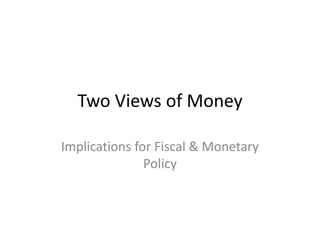
Two views of money
- 1. Two Views of Money Implications for Fiscal & Monetary Policy
- 2. Exogenous vs. Endogenous Money • Recap: – Orthodox (exogenous): Money is a commodity (e.g. gold, silver). It functions as medium of exchange. Agents not fooled by it; they respond only to changes in relative values of real goods - Money is neutral – Money enters the economy from without – imagine Fed Chairman Ben Bernanke flying around in a little helicopter making it rain cash!
- 3. Exogenous vs. Endogenous Money • Recap: – Heterodox (endogenous): money is no object – not a physical commodity w/ intrinsic value. Money cannot be neutral – in a monetary production economy (M – C – M’) – Keynes: “The possession of actual money lulls our disquietude; and the premium we require to make us part with money is a measure of the degree of our disquietude.” (GT, 1936)
- 4. Endogenous Money • Money enters the economy as a result of the need to finance real economic activity. – M – C … P … C’ – M’ • Production takes place before sale, which must be financed either internally or externally. For the economy as a whole this must be external. • Thus, loans are required to finance productive activity, which are then retired once the business enterprise realizes the increase in value through sales. • Horizontal Money Creation: Loans -> Deposits
- 5. Endogenous Money • Vertical Money Creation Process: – Government spending: The state’s liabilities are the money of account; high powered money; show up as net financial assets – Gov. Spending creates money; gov. taxation destroys it. – If G > T, then deficits accumulate to stocks of outstanding G liabilities – i.e. the national debt. – If G < T, then surpluses subtract from the stock of outstanding G liabilities – i.e. paying down the national debt. – More on this later
- 6. Monetary Policy (Exogenous Story) r Ms Equation of Exchange: MV = PQ Causality r* MD MQ
- 7. Monetary Policy (Endogenous Story) The CB cannot control the money supply r But, it can control the interest rate (fed funds rate). Equation of Exchange: Ms r* MV = PQ MD Causality MQ
- 8. Fiscal Policy • In order to get fiscal policy right, we need to understand how our monetary system works. • Being wrong can have disastrous consequences on the economy – i.e. Volcker Recession of 1981 • Quantity targets failed which caused the interest to rate to rise to really high levels. • Erroneously believed the inflation is related to the quantity of money in circulation • Caused a recession – probably responsible for starting the decline of American manufacturing (along with trade policy). • Exogenous story leads to belief that G can run out of money. Leads to fears of rising interest rates, unsustainable debt levels, etc.
- 9. Endogenous Money & Stock-Flow Accounting • In order to formulate good macro policy, we need to begin with good accounting: • Flows accumulate to stocks – Deficits are flows; debts are stocks – Surpluses are flows; savings are stocks • One’s financial asset is another’s financial liability: An IOU (liability) generates a flow of income to the holder of the IOU (asset)
- 10. Endogenous Money & Stock-Flow Accounting • There are three broad sectors to the economy: Domestic Private Sector Balance + Domestic Government Balance + Foreign Balance = 0 Over any given period, each sector will either run a surplus, a deficit, or a balanced budget. And they must sum to zero. This true by extension of the accounting principle that one’s financial asset is another’s financial liability.
